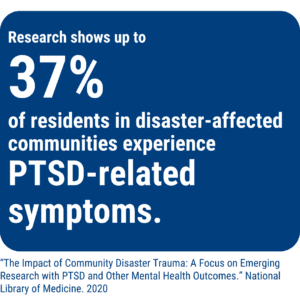The mental health impact of community trauma
When your community experiences a crisis, it can be hard to know where to turn. Community crises include events like natural disasters, acts of violence, sudden loss and other wide-spread trauma. Responding to a community crisis is important.
 Immediately after a crisis occurs, it’s common to see an increase in acute stress reactions, including anxiety, panic and confusion. This happens as people grapple with what has happened and the immediate next steps.
Immediately after a crisis occurs, it’s common to see an increase in acute stress reactions, including anxiety, panic and confusion. This happens as people grapple with what has happened and the immediate next steps.
When a crisis impacts a large group of people, those reactions can be amplified. Traditional support networks may also be unavailable. Neighbors, friends or family members who would normally be positive supports may be unable to provide care as they navigate their own reaction to the crisis.
This initial phase is typically marked by shock and disbelief. This can hinder peoples’ ability to make rational decisions and care for themselves and their families. The sudden loss of normalcy and the potential for displacement can increase feelings of helplessness and vulnerability.
In the longer term, the mental health impacts of a community crisis can manifest as chronic conditions such as:
- post-traumatic stress disorder (PTSD)
- depression
- prolonged grief
The disruption of social networks and the destruction of community infrastructure can leave individuals feeling isolated and unsupported. Economic instability and loss of livelihood further contribute to sustained stress and anxiety, making recovery a prolonged and challenging process.
Watch: The impact of Natural Disaster-related ACES on children’s mental health
Protective factors that help support community mental health after a crisis include:
Strong Social Support – Encouraging connections with family, friends, and neighbors helps reduce feelings of isolation and builds a sense of belonging.
Access to Mental Health Resources – Providing free and confidential counseling, crisis services, and support groups ensures that individuals can seek professional help when needed.
Open Communication – Creating safe spaces for people to talk about their emotions and experiences promotes healing and reduces stigma around seeking help.
Community Engagement – Volunteer opportunities, support networks, and local initiatives foster resilience and help people regain a sense of purpose and control.
Routine and Stability – Encouraging the return to normal routines, such as school, work, and social activities, provides structure and reassurance.
Education and Awareness – Sharing information about coping strategies, trauma responses, and available resources helps individuals recognize when they or others need support.
Compassionate Leadership – Leaders who openly address the crisis with honesty and empathy can instill hope and guide the community toward recovery.
Self-Care and Healthy Coping Strategies – Encouraging activities like exercise, mindfulness, creative expression, and rest can help manage stress and build resilience.
